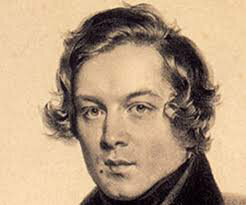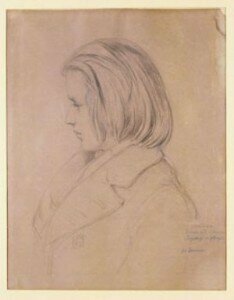
Robert Schumann
Brahms first visited the couple in Düsseldorf on 30 September 1853, and he stayed for four weeks. Both welcomed him warmly, and Robert was highly enthusiastic about the young man’s compositions; he even called him a genius and the coming savior of German music! Clearly the personal and musical consequences of that meeting would have far reaching implications.
Brahms eventually left for Leipzig, but learning of Robert’s attempted suicide rushed back to Düsseldorf. He visited Robert in the hospital, often accompanied by his friends Joseph Joachim and Albert Dietrich. But he also lived with Clara and the children in the Schumann house. However you look at it, Brahms was helplessly in love with Clara. He wrote in frustration during 1855, “I can do nothing but think of you… What have you done to me? Can’t you remove the spell you have cast over me?” The situation was, to put it mildly, rather messy. Yet, moral dilemmas, feelings of anxiety and guilt, and bent up sexual frustration found expression in some of the most intimate and emotional music of the 19th century.
In 1852 Robert Schumann assembled and published a collection of small pieces written during the tumultuous years of his courtship with Clara. He called the collection Bunte Blätter (Colored Leaves), and this emotional kaleidoscope bristles with the musical ambiguity conjured from his gradually splintering mind.
Robert Schumann: Bunte Blätter, Op. 99

Clara Schumann
In 1853, Clara set to work and composed her own set of variations on this particular theme by Robert. The mournful theme is followed by seven variations, with the last variation heavily laden with musical and extra-musical meaning. It has been suggested that this final variation “seems to go beyond any earthly limit,” a musical prayer possibly foreshadowing Schumann’s internment in Endenich within the same year. The work was finally published in the autumn of 1854, and bears the dedication “To my beloved husband, for 8 June, this poor new attempt from his old Clara.”
Clara Schumann: Variations on a Theme by Robert Schumann, Op. 20

Johannes Brahms
Clara excitedly wrote to Robert, “Brahms has had a splendid idea, a surprise for you, my Robert. He has interwoven my old theme with yours. I can already see you smile.” In a rare moment of lucidity, Robert wrote to Brahms from his hospital bed. “How I long to come to see you, dear friend, and hear your lovely variations played either by you or by Clara, of whose beautiful rendering Joachim told me in his letter. There is an exquisite coherence about the whole work, a wealth of fantastic glamour peculiarly your own, and, moreover, evidence of what to me is a new development on your part – I mean the profound skill with which you introduce the theme at odd moments, mysteriously, passionately, and again let it disappear completely. Then the wonderful close to the fourteenth variation, with its ingenious imitation in the second above; the fifteenth in G flat, with its glorious second part; and the last! Thank you, too, my dear Johannes, for all your kindness to my Clara. She speaks of it constantly in her letters… Be sure and write soon to your admiring and loving friend, R. Schumann.” The graceful dedication of the Brahms Op. 9 Variations read, “To Frau Clara Schumann, on a theme by him and dedicated to her.”
Johannes Brahms: Variations on a Theme by Schumann, Op. 9


